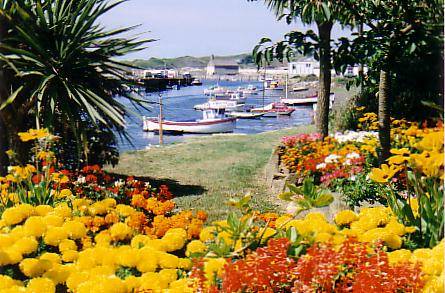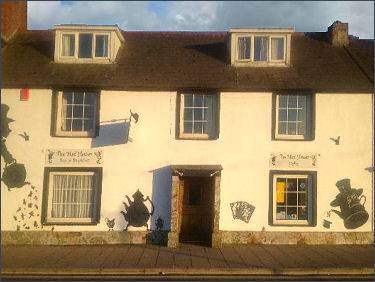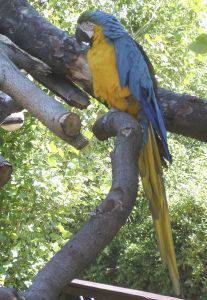Hayle
OS Grid ref:- SW560373
 Hayle, surrounded by three miles of golden sands and situated
on the opposite bank of beautiful St. Ives Bay, is one of Cornwall's oldest ports.
Hayle, surrounded by three miles of golden sands and situated
on the opposite bank of beautiful St. Ives Bay, is one of Cornwall's oldest ports.
The estuary is regarded as an international quality bird-watching spot. Birdlife include avocets, ospreys and a host of wading birds.
During the industrial Revolution the old wharves were once part of a large engineering business 'Harvey's of Hayle', the remains of this extensive complex, the hammer mill and the old mill pond, now encompassed by a park, can still be seen.
Hayle’s Oral History Centre, situated in the Old Brewery Offices, relates tales told by Hayle residents about life long ago in the town. The centre features a photographic display and anecdotes written by local people.
The large stretch of towans or sand dunes on the Hayle estuary is an ideal spot to swim, sunbathe or walk and offer superb views of St. Ives across the bay. The Hayle Estuary Reserve incorporates Copperhouse Pool, built in 1788 which is bordered by the subtropical King George V Memorial Walk.
 Phillack Church (OS Grid reference- SW 5638), dedicated to St Felicitas, was originally the parish church of the town of Hayle and dates to the fifteenth century. Much of the present building dates from the nineteenth century. It occupies the site of what was formerly a wooden oratory, followed around 700 A.D. with a stone chapel. It is more than likely this was situated under the nave and chancel of the later Norman Church.Two early stones have been found embedded in the church. One bears a 'Constantine' form of a Chi-Rho cross, a symbol of early Christianity. The stone, it is believed, may date to the fifth century; it was afterwards rebuilt into the wall directly above the apex of the arch of the doorway of the new church. The second is simple memorial stone bearing the name of 'Clo[tualus] [son of] Mo[bra]ttus', which has been dated between the fifth to eighth centuries, and now stands in the churchyard. Arthur G. Langdon (1896) recorded the existence of six stone crosses in the parish, including two in the churchyard.
Phillack Church (OS Grid reference- SW 5638), dedicated to St Felicitas, was originally the parish church of the town of Hayle and dates to the fifteenth century. Much of the present building dates from the nineteenth century. It occupies the site of what was formerly a wooden oratory, followed around 700 A.D. with a stone chapel. It is more than likely this was situated under the nave and chancel of the later Norman Church.Two early stones have been found embedded in the church. One bears a 'Constantine' form of a Chi-Rho cross, a symbol of early Christianity. The stone, it is believed, may date to the fifth century; it was afterwards rebuilt into the wall directly above the apex of the arch of the doorway of the new church. The second is simple memorial stone bearing the name of 'Clo[tualus] [son of] Mo[bra]ttus', which has been dated between the fifth to eighth centuries, and now stands in the churchyard. Arthur G. Langdon (1896) recorded the existence of six stone crosses in the parish, including two in the churchyard.
Evidence of Iron Age settlement exists at the fort on the hill above Carnsew Pool where the Plantation now stands. It is thought that Hayle, was an important centre for the neolithic tin industry, trading not only Irish and Breton people, but also the Phoenicians of the eastern Mediterranean. Evidence of this comes from finds of imported pottery including Romano/Grecian Amphorae - containers for wine and oil.
 Hayle, known in Cornish as Heyl, meaning estuary, offers a wide range of leisure activities and accomodation. Nearby Godrevy Lighthouse provided the inspiration for Virginia Wolff's novel 'To the Lighthouse'. The Hayle
estuary, stretching from Copperhouse to Lelant Saltings as an international quality bird-watching spot and provides a feeding ground for many species of migratory birds.
Hayle, known in Cornish as Heyl, meaning estuary, offers a wide range of leisure activities and accomodation. Nearby Godrevy Lighthouse provided the inspiration for Virginia Wolff's novel 'To the Lighthouse'. The Hayle
estuary, stretching from Copperhouse to Lelant Saltings as an international quality bird-watching spot and provides a feeding ground for many species of migratory birds.
Paradise Park
Paradise Park is home to a large collection of the world's rarest birds are kept, they include flamingos, toucans and parrots, as well as the Cornish otter sanctuary. Otter and penguin feeding times can also be viewed by visitors.
Paradise Park was established in 1973 as a tropical bird garden, since then otters, red pandas, native red squirrels and the rare Cornish Chough can all be seen here. The 'Fun Farm' is a favourite with children, and daily events bring visitors closer to the wildlife. The Park is set around a Victorian walled garden, and features tropical plants which thrive in Cornwall's mild climate. In 2005 the new JungleBarn indoor play centre was opened, so that there is plenty of active fun for children even the weather is cold and wet.